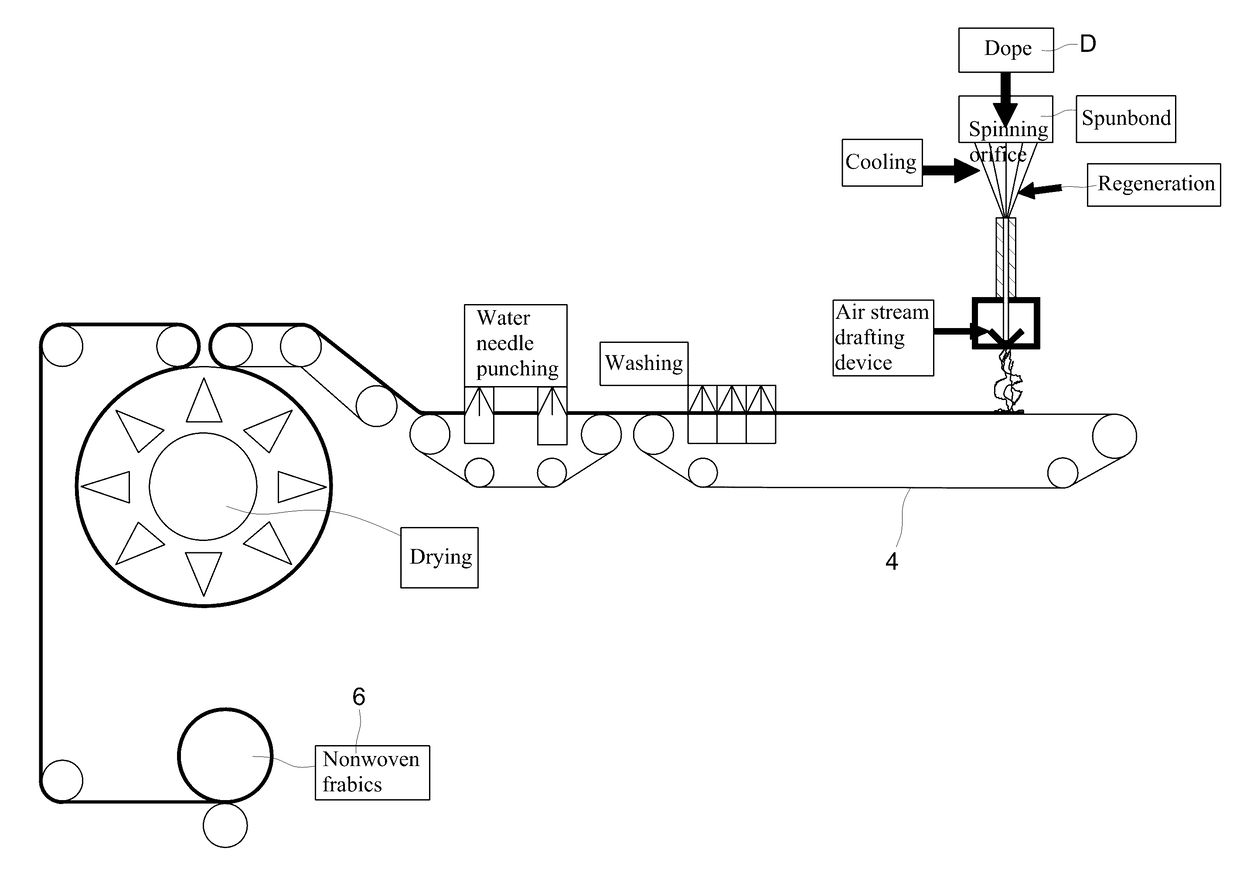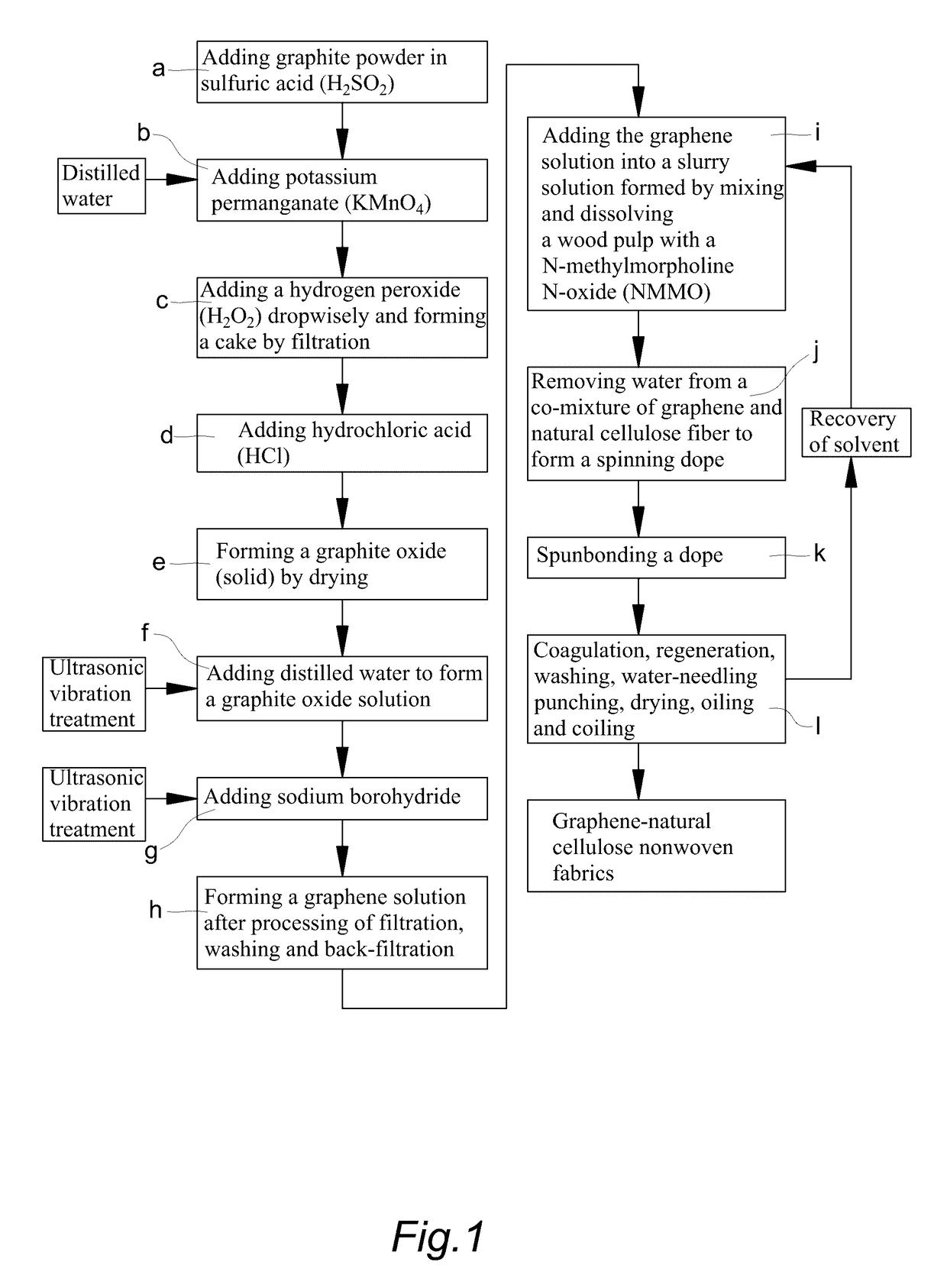Method of Preparing of Natural Graphene Cellulose Blended Spunbond Nonwoven Fabric
a technology of graphene cellulose and nonwoven fabric, which is applied in the direction of sustainable manufacturing/processing, final product manufacturing, artificial filament recovery, etc., can solve the problems of unsafe process, harmful to human health, nausea and other symptoms, etc., and achieve the effect of avoiding the health hazards of hydrazine hydrate solutions, reducing the risk of hydrazine hydrate contamination, and improving the antistatic property and thermal conductivity of the present natural graphene cellulose non
- Summary
- Abstract
- Description
- Claims
- Application Information
AI Technical Summary
Benefits of technology
Problems solved by technology
Method used
Image
Examples
example 1
[0052](a) Adding sulfuric acid (H2SO4) in a graphite powder, which comprises pouring graphite powder 1.0 g into 250 ml beaker, and under ice-cooling environment, adding 23 ml of sulfuric acid, then stirring it for 30 minutes;
[0053](b) Adding potassium permanganate (KMnO4), which comprises: adding a potassium permanganate 4.0 g into a mixture obtained from step (a), stirring it for 1 to 2 hours, and adding an appropriate amount of distilled water, until that none of purple smoke which is generated by reacting with the potassium permanganate, is formed form the distilled water;
[0054](c) Adding a hydrogen peroxide (H2O2) and conducting a filtration, which comprises: dropwisely adding 5.0% to 10.0% hydrogen peroxide in a solution obtained from step (b), where bubbles are formed from solution during the hydrogen peroxide-adding period, and the addition of hydrogen peroxide is continuously proceeded until that none of bubble is formed form the solution, simultaneously the solution is chan...
example 2
[0064](a) Adding sulfuric acid (H2SO4) in a graphite powder, which comprises pouring graphite powder 1.0 g into 250 ml beaker, and under ice-cooling environment, adding 23 ml of sulfuric acid, then stirring it for 30 minutes;
[0065](b) Adding potassium permanganate (KMnO4), which comprises: adding a potassium permanganate 4.0 g into a mixture obtained from step (a), stirring it for 1 to 2 hours, and adding an appropriate amount of distilled water, until that none of purple smoke which is generated by reacting with the potassium permanganate, is formed form the distilled water;
[0066](c) Adding a hydrogen peroxide (H2O2) and conducting a filtration, which comprises: dropwisely adding 5.0% to 10.0% hydrogen peroxide in a solution obtained from step (b), where bubbles are formed from solution during the hydrogen peroxide-adding period, and the addition of hydrogen peroxide is continuously proceeded until that none of bubble is formed form the solution, simultaneously the solution is chan...
example 3 (
Antistatic Performance Test)
[0077]Antistatic performance is tested according to FTTS-FA-009 (Specified Requirement of Antistatic Textile, and with reference to the standard of AATCC76 (Electrical Resistivity Fabrics) by using concentric electrode surface resistance meters, and the surface resistance value of each sample, the half-life of charge recession and frictional-charged electrostatic potential are tested to evaluate the antistatic effect of the natural graphene cellulose blended spunbond nonwoven fabrics. Results of antistatic performance test made to each of the fabric Samples No. 1 to 24 are shown in Table 2.
TABLE 2Antistatic Performance Test of natural graphenecellulose blended spunbond nonwoven fabricshalf-frictional-Blendinglife ofchargePolymer-ratio ofchargeelectro-izationgrapheneSurfacereces-staticTestSam-degree ofsolutionResistancesionpotentialresultplecellulose(wt. %)(Ω)(sec.)(V)(grade)16500.019.54 × 109255126500.038.40 × 109218136500.057.32 × 109202146500.084.68 × 1...
PUM
| Property | Measurement | Unit |
|---|---|---|
| temperature | aaaaa | aaaaa |
| processing time | aaaaa | aaaaa |
| temperature | aaaaa | aaaaa |
Abstract
Description
Claims
Application Information
 Login to View More
Login to View More - R&D
- Intellectual Property
- Life Sciences
- Materials
- Tech Scout
- Unparalleled Data Quality
- Higher Quality Content
- 60% Fewer Hallucinations
Browse by: Latest US Patents, China's latest patents, Technical Efficacy Thesaurus, Application Domain, Technology Topic, Popular Technical Reports.
© 2025 PatSnap. All rights reserved.Legal|Privacy policy|Modern Slavery Act Transparency Statement|Sitemap|About US| Contact US: help@patsnap.com



